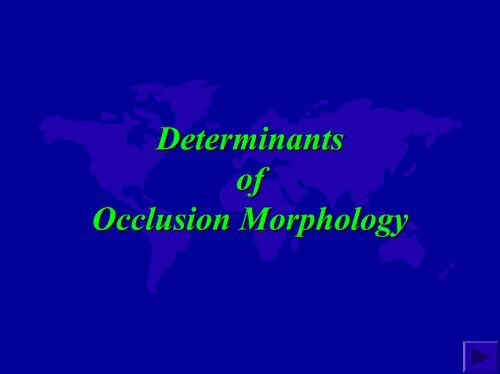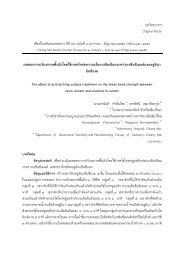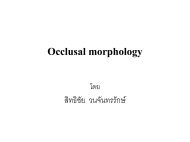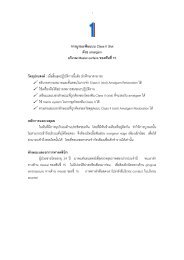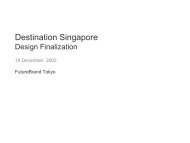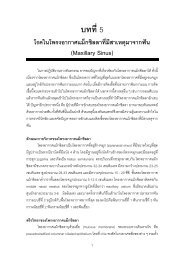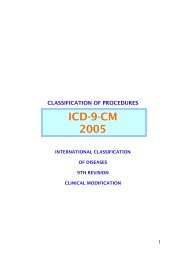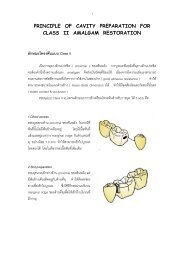Determinants of Occlusion Morphology
Determinants of Occlusion Morphology
Determinants of Occlusion Morphology
Create successful ePaper yourself
Turn your PDF publications into a flip-book with our unique Google optimized e-Paper software.
<strong>Determinants</strong><br />
<strong>of</strong><br />
<strong>Occlusion</strong> <strong>Morphology</strong>
Structures control mandibular movement<br />
• Posterior controlling factor : TMJ<br />
• Anterior controlling factor : anterior teeth<br />
• Posterior teeth<br />
– are positioned between these two<br />
controlling factors<br />
– can be affected by both to varying<br />
degrees
Posterior controlling factors<br />
Condylar guidance<br />
– is the angle at which the condyle moves<br />
away from a horizontal reference plane<br />
from CR along the articular eminence <strong>of</strong><br />
the mandibular fossa<br />
– depends on the steepness <strong>of</strong> the articular<br />
eminence<br />
– considered to be fixed factor, unalterable
CG angle when the mandible move laterally is<br />
greater than when mandibule protrudes<br />
straight forward due to medial wall <strong>of</strong> the<br />
mandibular fossa is generally greater than<br />
articular eminenece anterior to condyle.<br />
condyle
Anterior controlling factors<br />
• Anterior guidance<br />
– the incisal edges <strong>of</strong> the mandibular teeth<br />
occlude with lingual surface <strong>of</strong> the maxillary<br />
teeth as mandible protrude or move laterally<br />
– The steepness <strong>of</strong> these lingual surface<br />
determines the amount <strong>of</strong> vertical movement<br />
<strong>of</strong> mandible<br />
– The anterior guidance consider to be a<br />
variable rather can be alterated during by<br />
dental procedure
• The morphologic characteristics <strong>of</strong> each posterior<br />
tooth must be in harmony with those <strong>of</strong> its opposing<br />
tooth to teeth during all eccentric mandibular<br />
movements.<br />
• Therefore the exact morphology <strong>of</strong> the tooth is<br />
influenced by the pathway it travel across its<br />
opposing tooth to teeth.<br />
• Nearer the tooth is to the TMJ, the more the more<br />
joint influences its movement.
Occlusal surface <strong>of</strong> posterior teeth<br />
can be effected by the significance <strong>of</strong> the<br />
anterior and condylar guidance in two<br />
manners<br />
– factors influences vertical components<br />
(Height)<br />
– factors influences horizontal components<br />
(Width)
Vertical determinants <strong>of</strong><br />
occlusal morphology<br />
Influences the heights <strong>of</strong> cusps and the depths <strong>of</strong><br />
fossae<br />
1. The anterior controlling factor <strong>of</strong><br />
mandibular movement<br />
(i.e., anterior guidance)<br />
2. The posterior controlling factor <strong>of</strong><br />
mandibular movement<br />
(i.e., condylar guildance) guildance<br />
3. The nearess <strong>of</strong> the cusp to these controlling<br />
factors.
Posterior centric cusps<br />
• are generally developed to contact in the<br />
intercuspal position but to disocclude during<br />
eccentric mandibular movements<br />
• must be long enough to contact in the<br />
intercuspal position but not so long that they<br />
contact during eccentric movements.
Angle <strong>of</strong> articular eminence<br />
(Effect <strong>of</strong> condylar guidance on cusp height)<br />
• Protrusion: the condyle descends along the<br />
steepness <strong>of</strong> the articular eminence.<br />
• more steepness<br />
– more the condyle is forced to move<br />
inferiorly as it shifts anteriorly<br />
– greater vertical movement <strong>of</strong> condyle, condyle<br />
mandible, mandibular teeth
45 o & 45 o
60 o & 60 o
Effect <strong>of</strong> anterior guidance on cusp height<br />
• Anterior guidance is a functional<br />
relationship between the maxillary and<br />
mandibular anterior teeth.<br />
• Anterior guidance is consisted <strong>of</strong><br />
– vertical overlap <strong>of</strong> anterior teeth.<br />
– horizontal overlaps <strong>of</strong> anterior teeth.
Examples <strong>of</strong> anterior guidance<br />
Same vertical overlap, varying horizontal overlap
Increase in horizontal overlap leads to a<br />
decreased anterior guidance angle, less<br />
vertical component to mandibular<br />
movement, and flatter posterior cusps.
Same horizontal overlap, varying vertical overlap
Increase in vertical overlap produced an<br />
increased anterior guidance angle, more<br />
vertical component to mandibular<br />
movement, and steep posterior cusps
Effect <strong>of</strong> plan <strong>of</strong> occlusion on cusp height<br />
• Plane <strong>of</strong> occlusion id an imagination line<br />
touching incisal edges <strong>of</strong> maxillary anterior<br />
teeth and the cusps <strong>of</strong> the posterior teeth.<br />
• The relationship <strong>of</strong> the plan to the angle <strong>of</strong><br />
the articular eminence influences the<br />
steepness <strong>of</strong> the cusps
Effect <strong>of</strong> curve <strong>of</strong> Spee on cusp height<br />
• the curve <strong>of</strong> Spee is anteroposterior curve<br />
extending from the tip <strong>of</strong> the mandibular<br />
canine along the buccal cusp tips <strong>of</strong><br />
mandibular posterior teeth<br />
• Its curvature can be decribed in terms <strong>of</strong> the<br />
length <strong>of</strong> the radius <strong>of</strong> the curve
A short radius the<br />
curve is more acute<br />
that with a longer<br />
radius
Orientation <strong>of</strong> curve <strong>of</strong> Spee
To be continued
Effect <strong>of</strong> mandibular lateral<br />
translation movement on cusp height<br />
• Bennett movement: Mandibular lateral translation<br />
movement is a bodily sideshift <strong>of</strong> the mandible that<br />
occurs during lateral movements.<br />
• During a lateral excursion the orbiting condyle<br />
moves downward and forward, and inward<br />
• Opposite condyle rotate around axes in mandibular<br />
fossa (rotating ( rotating condyle)<br />
condyle
• TM ligament <strong>of</strong><br />
the rotating<br />
condyle is very<br />
tight and the<br />
medial wall is<br />
close to the<br />
orbiting condyle<br />
• a pure arcing<br />
movement is<br />
made around the<br />
axis <strong>of</strong> rotation<br />
condyle
Degree <strong>of</strong> inward movement <strong>of</strong><br />
condyle for lateral translation<br />
Determined by 2 factors<br />
– morphology <strong>of</strong> the medial wall <strong>of</strong> the<br />
mandibular fossa<br />
– inner horizontal portion <strong>of</strong> the TM<br />
ligament, ligament,<br />
which attaches to the<br />
lateral pole <strong>of</strong> the rotating condyle.<br />
condyle
• looseness <strong>of</strong> the<br />
TM ligament &<br />
the medial wall <strong>of</strong><br />
the mandibular<br />
fossa lies medial<br />
to an arc around<br />
the axis <strong>of</strong> the<br />
rotating condyle<br />
• condyle is moved<br />
inwardly to the<br />
medial wall and<br />
produces a<br />
mandibular<br />
lateral translation<br />
movement.
Effect <strong>of</strong> mandibular lateral translation<br />
movement on cusp height<br />
• Effect <strong>of</strong> the amount <strong>of</strong> lateral translation<br />
movement on cusp height<br />
• Effect <strong>of</strong> the direction <strong>of</strong> lateral translation<br />
movement on cusp height<br />
• Effect <strong>of</strong> the timing <strong>of</strong> lateral translation<br />
movement on cusp height
Effect <strong>of</strong> the amount <strong>of</strong> lateral<br />
translation movement on cusp height<br />
The greater the lateral translation movement, the<br />
shorter is the posterior cusp
The greater the lateral translation movement,<br />
the shorter is the posterior cusp
Effect <strong>of</strong> the direction <strong>of</strong> lateral<br />
translation movement on cusp height<br />
• determined by the morphology and<br />
ligamentous attachments <strong>of</strong> the TMJ<br />
undergoing rotation<br />
– Movement occurs within a 60-degree (or less)<br />
cone whose apex is located at the axis <strong>of</strong><br />
rotation<br />
– More superior the lateral translation<br />
movement, the shorter is the posterior cusp
movement occurs within a 60-degree (or less) cone<br />
whose apex is located at the axis <strong>of</strong> rotation
More superior the lateral translation movement,<br />
the shorter is the posterior cusp
Effect <strong>of</strong> the timing <strong>of</strong> lateral<br />
translation movement on cusp height<br />
• lateral translation movement<br />
– occurs early, a shift is seen even before the<br />
condyle begins to translate from the fossa. This<br />
is called an immediate lateral sideshift<br />
– it occurs in conjunction with an eccentric<br />
movement, the movement is known as a<br />
progressive lateral translation movement or<br />
progressive sideshift.
1. Immediate sideshift, sideshift,<br />
shorter posterior cusp<br />
2. progressive sideshift, sideshift,<br />
longer cusp
Horizontal determinants <strong>of</strong> occlusal morphology<br />
• distance from rotating condyle on ridge and groove<br />
direction<br />
• distance from midsagittal plane on ridge and groove<br />
direction<br />
• distance from rotating condyles and from midsagittal<br />
plane on ridge and groove direction<br />
• Effect <strong>of</strong> mandibular lateral translation movement on<br />
ridge and groove direction<br />
• intercondylar distance on ridge and groove direction<br />
• relationship between anterior and posterior controlling<br />
factors
Effect <strong>of</strong> distance from rotating condyle<br />
on ridge and groove direction<br />
• The greater the distance <strong>of</strong> the tooth from the<br />
rotating condyle, condyle,<br />
the wider is the angle<br />
formed by the laterotrusive and mediotrusive<br />
pathways.
Mandibular teeth<br />
A = Mediotrusive pathway, pathway,<br />
B = Laterotrusive pathway
Maxillary teeth<br />
A = Mediotrusive pathway, pathway,<br />
B = Laterotrusive pathway
Effect <strong>of</strong> distance from midsagittal<br />
plane on ridge and groove direction<br />
• The greater the distance <strong>of</strong> the tooth from the<br />
midsagittal plane, the wider the angle formed<br />
by the laterotrusive and mediotrusive<br />
pathways. (both maxillary and mandibular<br />
teeth)
Effect <strong>of</strong> distance from rotating condyles and from<br />
midsagittal plane on ridge and groove direction<br />
• More anterior the<br />
tooth in the dental<br />
arch, the wider is the<br />
angle formed by the<br />
laterotrusive and<br />
mediotrusive<br />
pathways
Effect <strong>of</strong> mandibular lateral translation<br />
movement on ridge and groove direction<br />
• As the amount <strong>of</strong> lateral translation<br />
movement increases, the angle between the<br />
mediotrusive and laterotrusive pathways<br />
generated by the centric cusp tips increases.<br />
(both maxillary and mandibular teeth)
Effect <strong>of</strong> anterolateral and posterolateral<br />
translation movement <strong>of</strong> the rotating condyle<br />
• The more anteriolateral the movement <strong>of</strong> the<br />
rotating condyle, condyle,<br />
the smaller is the angle<br />
formed by the mediotrusive and laterotrusive<br />
pathways.<br />
• The more posterolateral the movement <strong>of</strong> the<br />
rotating condyle, condyle,<br />
the wider is the angle<br />
formed by the mediotrusive and laterotrusive<br />
pathways<br />
• (both maxillary and mandibular teeth)
Intercondylar distance on ridge and<br />
groove direction
Relationship between anterior and<br />
posterior controlling factors
Relationship between anterior and<br />
posterior controlling factors
Thank you


